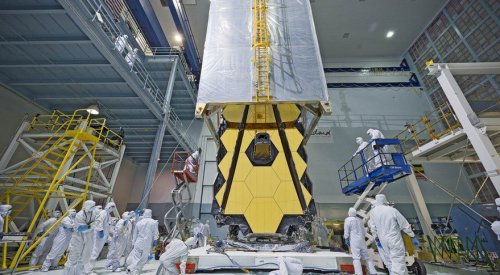SANTA FE, N.M. — NASA’s James Webb Space Telescope shows no signs of damage after an “anomaly” during a vibration test earlier in the month, the agency announced Dec. 23.
In a statement posted on the JWST web site, NASA said that engineers were making progress tracking down the root cause of the Dec. 3 incident that halted vibration testing of the telescope’s mirror assembly and instruments, known as the Optical Telescope element and Integrated Science (OTIS).
“All visual and ultrasonic examinations of the [telescope] structure continue to show it to be sound,” NASA said in the update. “Currently, the team is continuing their analyses with the goal of having a review of their findings, conclusions and plans for resuming vibration testing in January.”
The OTIS assembly, which includes the telescope’s 6.5-meter segmented primary mirror, secondary mirror and associated structures, and its suite of four science instruments, were undergoing vibration testing at the Goddard Space Flight Center Dec. 3 when engineers detected “anomalous readings” from accelerometers attached to the telescope. NASA halted the vibration tests to study the data as well as inspect the telescope for any damage.
NASA has not provided additional details on the nature of the vibration anomaly. The agency said in its latest update that, since the anomaly, the spacecraft team “successfully conducted two low level vibrations of the telescope.”
The vibration tests, as well as planned acoustic tests, are designed to simulate the environment JWST will experience during its launch on an Ariane 5 in late 2018. “We are about to subject this beautiful beast, which is finished, to see if it will survive launch,” said John Mather, the JWST senior project scientist, at a Nov. 2 media event at Goddard about the telescope. “We expect it to, but we still have to prove it.”
It’s unclear that effect the delay in the vibration and acoustic testing will have on JWST’s schedule. At the November event, Bill Ochs, NASA JWST project manager, said plans then called for shipping OTIS in February to the Johnson Space Center, where it will undergo thermal vacuum tests in a refurbished Apollo-era chamber there. It would then go in mid-2017 to a Northrop Grumman facility in Southern California to be integrated with the spacecraft bus and sunshield, and then undergo further testing before shipping to the French Guiana launch site in mid-2018.
However, project officials have emphasized that JWST has healthy schedule reserves put into place after a “replan” of the project in 2011, when cost and schedule overruns threatened JWST with cancellation. Those reserves are intended to mitigate any effect on the mission’s overall schedule from testing delays.
The replan provided JWST more schedule margin than required for a typical NASA project “because it’s Webb and we knew there would be additional complications,” said Scott Willoughby, Northrop Grumman vice president and program manager for JWST, in an interview at the Nov. 2 NASA event. “We’re right in line to where we need to be at this point in time, with two years to go before launch.”
- Missile defense tracking systems need to move to orbit, leaders say
- Trump adviser sees Pence playing a major role in space policy
- Congress questions report on benefits of Asteroid Redirect Mission
- How Trump Could Wage a War on Scientific Expertise
- Europe commits to the space station and ExoMars as part of $11 billion in commitments to ESA
Share with your friends

(0) Comments
This article comments are currently no :(